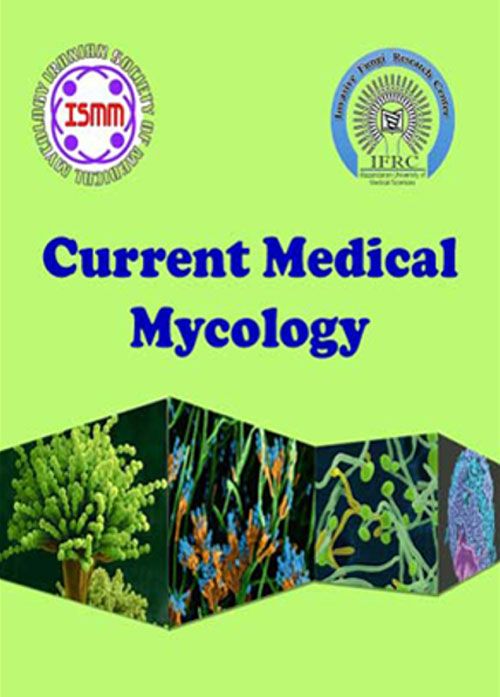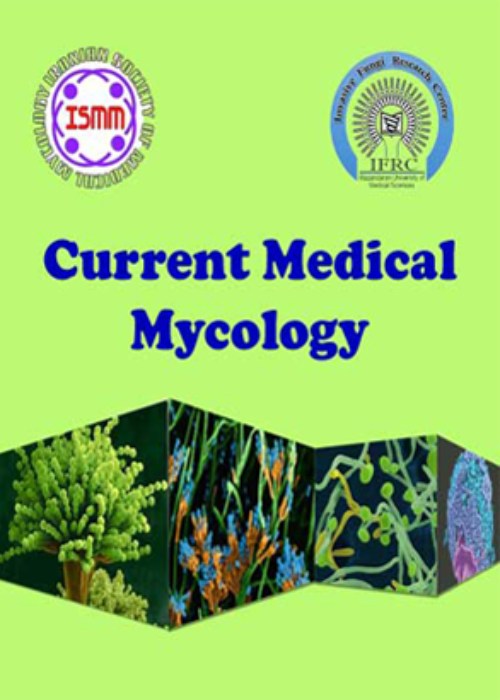فهرست مطالب

Current Medical Mycology
Volume:7 Issue: 3, Sep 2021
- تاریخ انتشار: 1400/10/29
- تعداد عناوین: 8
-
-
Pages 1-8Background and Purpose
The frequency and genetic diversity of black fungi in environmental and clinical settings have not been fully studied in Iran. This study aimed to identify and evaluate intra- and inter-species DNA sequence variation and also understand the phylogenetic relationships of melanized fungi and relatives isolated from different geographical regions of Iran.
Materials and MethodsIn total, 111 clinical and environmental strains of dematiaceous fungi were isolated, and their internal transcribed spacer ribosomal DNA(rDNA) regions were sequenced and analyzed.
ResultsAn inter-species nucleotide sequence diversity rate of 1 to 464 nucleotides was observed between the species. Intra-species differences were found in the strains of Alternaria alternata, Cladosporium cladosporioides, Alternaria tenuissima, Curvularia spicifera, Aureobasidium pullulans, Curvularia hawaiiensis, Neoscytalidium dimidiatum,Alternaria terricola, Alternaria chlamydospora, Didymella glomerata, and Drechslera dematioidea by 0–59, 0–22, 0–4, 0–4, 0–3, 0–2, 0–2, 0–2, 0–2, 0–1, and 0–1 nt, respectively.
ConclusionThe internal transcribed spacer rDNA is useful for the discrimination of several taxa of dematiaceous fungi. However, a better understanding of the taxonomy of species of Alternaria requires a larger rDNA region or a library of other gene sequences.
Keywords: Dematiaceous fungi, Iran, ITS rDNA region, Molecular identification -
Pages 9-12Background and Purpose
The present study was performed to raise attention on thefrequency of Candida spp. and evaluation of risk factors of candiduria in neonates andchildren.
Materials and MethodsIn total, 60 urine samples were collected from the suspectedneonates and children. Identification of Candida at species level was performed usingthe polymerase chain reaction-restriction fragment length polymorphism approach.
ResultsThe restriction fragment length polymorphism fingerprint analysis revealedthat Candida parapsilosis (n=17; 28.33 %) is the most prevalent isolated speciesfollowed by Candida albicans (n=9; 15%), Candida tropicalis (n=4; 9.52%), and C.glabrata (n=2; 4.76%). All of the C. albicans and C. parapsilosis complex strains wereidentified as C. albicans with HWP1 gene primers and using the NlaIII restrictionenzyme activity, respectively. In this study, none of the mentioned factors was the causeof infection, but they could be considered risk factors. The mean hospital stay was 21days (range: 7-21 days). More than 90% of the patients had a urinary catheter, and about26% of them received antibiotics. Regarding the risk factors, there was no significantdifference between the two groups of candidiasis in terms of C. albicans and nonalbicans Candida (P<0.01).
ConclusionCandiduria has always been a challenging issue, especially in childrenadmitted to hospitals. Outcome of candiduria in patients with generally healthy is little.
Keywords: Candiduria, Candida species, children, neonates, risk factors -
Pages 13-17Background and Purpose
Given the important role of Malassezia spp. in skin diseasesand other associated infections in neonates, this study aimed to investigate the presenceand frequency of Malassezia spp. in the skin of neonates hospitalized in neonatalintensive care units and their mothers using culture and accurate molecular-basedmethods.
Materials and MethodsIn total, 205 samples were collected from 130 neonates (>4-day-old) and 75 mothers. Isolation of Malassezia spp. from the skin was performed usingLeeming-Notman agar and modified Dixon agar media. To compare the Malasseziamicroflora on the skin of the neonates and their mothers, a polymerase chain reactionsequencing method was performed for spp. identification of 92 isolates obtained fromneonates and their mothers. Moreover, possible associated risk factors for thecolonization of Malassezia spp. on the skin were recorded.
ResultsCultures from 62.3% of neonates and 77.3% of mothers were positive forMalassezia spp. growth. Malassezia globosa was the most prevalent isolated spp. foundin the skin of the study population. It is noteworthy that a rare Malassezia spp.,Malassezia arunalokei, was isolated from the skin of one neonate. There was a 76%similarity between the mother-neonate isolate sequences results. The statistical analysisshowed that the type of feeding is a significant (P<0.001) associated factor forMalassezia skin colonization.
ConclusionThe findings support the hypothesis that the colonization of Malassezia inneonates is significantly influenced by that of the mother, and this may be associatedwith breastfeeding.
Keywords: Breastfeedings, Malassezia, M. arunalokei, neonate, sequencing -
Pages 18-21Background and Purpose
Resistance to antifungal drugs is increasing among Candida isolates from patients with vulvovaginal candidiasis (VVC). Lack of correct diagnosis of Candida causing VVC and the experimental use of antifungal drugs are the main causes of this resistance. This study aimed to determine the susceptibility of antifungal drugs against Candida species isolated from VVC in Northeastern Iran.
Materials and MethodsAmong women suspected of VVC, 189 vaginal dischargespecimens were evaluated. Candida isolates detected by polymerase chain reactionrestriction fragment length polymorphism were examined by standard antifungal diskdiffusion susceptibility testing method for voriconazole, itraconazole, fluconazole, andketoconazole. The susceptibility pattern of these antifungals was reported as sensitive,susceptible dose-dependent, and resistant. The results were evaluated by SPSS software and analyzed by Pearson chi-squared test.
ResultsAmong the vaginal specimens, 108 out of 189 Candida isolates were identifiedas C. albicans, C. glabrata, C. kefyr, C. parapsilosis, and C. tropicalis. The susceptibilityrates of Candida isolates to voriconazole, ketoconazole, itraconazole, and fluconazolewere 92.6%, 90.7%, 68.5%, and 63.9%, respectively. Moreover, the resistance rates tofluconazole, itraconazole, ketoconazole, and itraconazole were 15.7%, 8.3%, 1.9%, and1.9%, respectively. The C. glabrata and C. albicans isolates were resistant to antifungaldiscs among 93% and 20% of the specimens, respectively.
ConclusionThe C. glabrata and C. albicans species showed the highest resistance toantifungal drugs. Furthermore, Candida isolates showed the highest sensitivity tovoriconazole and ketoconazole and the lowest sensitivity to fluconazole.
Keywords: Azole, Northeastern Iran, Resistance, Sensitivity, Vulvovaginal candidiasis -
Pages 22-28Background and Purpose
Rapid surge of invasive mucormycosis has surprised the Indian healthcare system amidst the coronavirus disease-19 (COVID-19) pandemic. Hence, there is an urgent need to find the risk factors for the sudden rise in cases of invasive mucormycosis among COVID-19 patients. This study aimed to find crucial risk factors for the sudden surge of invasive mucormycosis in India.
Materials and MethodsThis case-control study included 77 cases of COVID-19 associated mucormycosis (CAM) who matched the controls (45 controls) in terms of age , gender, and COVID-19 disease severity. The control group included subjects that matched controls without mucormycosis confirmed by reverse transcription-polymerase chain reaction at our tertiary care center during April-May 2021. Probable predisposing factors, such as duration of diabetes mellitus (DM), history of recent hospitalization, duration of hospital stay, mode of the received oxygen supplementation, and use of steroids, zinc, vitamin c, and any other specific drugs were collected and compared between the two groups. Moreover, the laboratory parameters, like glycated hemoglobin (HbA1c), highly sensitive C-reactive protein (hs-CRP),and erythrocyte sedimentation rate (ESR) were analyzed to find out the significant association with CAM.
ResultsDM (Odds ratio=7.7, 95% CI 3.30-18.12; P=<0.0001) and high glycatedhemoglobin level (HbA1c>7.5 gm %) (odds ratio=6.2, 95% CI 1.4-26.7; P=0.014) weresignificant risk factors for the development of invasive mucormycosis among the COVID-19 cases. A higher number of mild COVID-19 cases developed CAM, compared to the moderate to severe cases (59.7% vs 40.3%). Use of systemic corticosteroids (odd ratio=5 with 95% CI 1.5-16.9; P=0.007) was found to be a risk factor for invasive mucormycosis only in mild COVID-19 cases. Use of oxygen, zinc, and vitamin C supplementation, and proprietary medicine did not lead to a significant risk of invasive mucormycosis in cases, compared to controls. Cases with invasive mucormycosis had a higher level of inflammatory markers (hsCRP and ESR, P=<0.001 and 0.002,respectively), compared to the controls.
ConclusionUncontrolled and new-onset DM and the use of systemic corticosteroids in mild cases were significantly associated with a higher risk of invasive mucormycosis in COVID-19 cases. There should be a strong recommendation against the use of systemic corticosteroids in mild COVID-19 cases.
Keywords: COVID-19, Diabetes Mellitus, Invasive Mucormycosis, risk factors, Systemic Corticosteroids -
Pages 29-35Background and Purpose
In Iranian culture, aromatic waters harboring a slight amount of essential oil have been popularly used for many years as a pleasant non-alcoholic drink with various medicinal properties.In this study, chemical composition of Zataria multiflora Boiss. (ZM) aromatic water was determined and its in vitro and in vivo antifungal properties were investigated.
Materials and MethodsChemical composition of the essential oil extracted from aromatic water (AW) of ZM was analyzed by Gas chromatography and gas chromatography-mass spectrometry (GC-MS). The antimicrobial activity of the AW against Candida species was determined by broth micro-dilution methods. Additionally, biofilm formation inhibition and antioxidant activity of the AW were measured using XTT reduction and DPPH methods, respectively. Antifungal activities of the AW in the prevention and/or treatment of gastrointestinal (GI) candidiasis in animal models were also evaluated.
ResultsThe GC-MS analysis revealed that the major constituents of ZM AW were Carvacrol (46.56%) and Thymol (40.67%). The ZM AW inhibited the growth and biofilm formation of Candida species in the range of 0.25-0.5 V/V. Moreover, ZM AW significantly decreased Candida colonization in therapeutic groups (P<0.05).
ConclusionGiven the wide therapeutic potential of ZM AW, including antifungal and antioxidant activities, it might be possible to use it in the management of mucocutaneous or alimentary candidiasis.
Keywords: aromatic water, Antifungal property, candida albicans, Essential oil, Zataria multiflora Boiss -
Pages 36-43Background and Purpose
Vulvovaginal candidiasis is considered the second mostprevalent gynecologic infection among women and one of the main reasons for referring to a gynecologist. During recent decades, probiotic usage has been defined as one of the therapeutic regimens for vaginal candidiasis management, but these findings were controversial. The current study was conducted to determine the effect of fluconazole plus vaginal and oral probiotics supplementation on clinical and mycological improvement of vaginal candidiasis concomitant with antifungal susceptibility of Candida species to fluconazole.
Materials and MethodsThis double-blind, randomized, placebo-controlled trial wasconducted on 76 women with vaginal candidiasis admitted to Naghavi and Imam RezaGynecology Clinics in Kashan, Central Iran, from July 2017 to March 2020. Patientswere diagnosed according to vaginal candidiasis symptoms and positive culture forCandida species. The patients were divided into two groups; one of them receivedfluconazole plus vaginal and oral probiotics, while the other one received fluconazolewith placebo. The clinical and mycological findings were recorded before and after thetreatment. In vitro, the fluconazole susceptibility test was determined by themicrodilution method according to the Clinical and Laboratory Standards Institute (M27-A3) for the baseline Candida isolates.
ResultsBased on the findings, 35 days after the intervention, a significant reductionwas reported in vaginal candidiasis symptoms in the probiotics supplementation group.Although probiotics supplementation therapy was a better mycological cure, comparedto the fluconazole with the placebo group, this difference was not significant (68.4% vs.46.9%, P=0.184). Exclusion of resistant and susceptible dose-dependent strain in theregression model demonstrated a significant reduction in positive culture probiotics inthe supplementation group.
ConclusionOral and vaginal supplementation with probiotics for 4 weeks played asignificant role in the elimination of vaginal candidiasis symptoms. Adjustment ofclinical and mycological responses with drug resistance patterns of patients could open a promising horizon for probiotics consumption as a complementary treatment.
Keywords: Fluconazole, Probiotic, Vulvovaginal candidiasis -
Pages 44-49Background and Purpose
The COVID-19 pandemic resulted in an overload of health services and healthcare professionals. The result is a setback in health promotion and prevention, delays in diagnosis, and deaths from other diseases that are currently receiving inadequate attention. This article illustrates the risk of this negligence.
Case reportThis study aimed to report a case of coinfection of disseminated cryptococcosis and BK virus in a patient without a previous diagnosis of human immunodeficiency virus infection and COVID-19 negative in the context of the COVID-19 pandemic. Despite receiving antifungal therapy, the patient died.
ConclusionThis fatal case is a warning regarding delay of diagnosis and neglect ofother serious illnesses owing to the current pandemic, including fungal diseases and neglected diagnoses.
Keywords: BK Virus, Fungal meningitis, HIV-AIDS, opportunistic diseases, Pandemic


